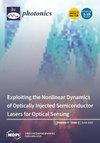基于全息技术的改进型角频谱法研究
IF 1.9
4区 物理与天体物理
Q2 OPTICS
引用次数: 0
摘要
数字全息(DH)是一种新型、实时、无损、定量的相位对比成像方法,特别适用于无标记活体生物细胞成像和实时动态监测。它是目前国内外光学与生物医学交叉学科领域的研究热点。本文提出了一种基于全息技术的改进角谱算法,该算法根据相位信息重建细胞全息图。在改进的角光谱算法下,利用全息技术在不同衍射距离下重建的光学图像和染色体细胞图像进行了分析和比较。选择了重建染色体细胞图像的最佳衍射距离,并比较了使用传统角光谱算法、角光谱算法与 GS 结合以及改进角光谱算法再现的染色体细胞图像。不同模型的对比实验表明,在基于相位信息重建细胞图像方面,建议的算法优于传统的角谱算法。此外,实验还表明,使用改进算法重建的图像可以解析高信噪比信息。这种算法改进为临床诊断中的细胞检测提供了新的应用,更适合实际应用中的细胞相位重建。本文章由计算机程序翻译,如有差异,请以英文原文为准。
Investigation of an Improved Angular Spectrum Method Based on Holography
Digital holography (DH) is a novel, real-time, non-destructive, and quantitative phase-contrast imaging method that is particularly suitable for label-free live biological cell imaging and real-time dynamic monitoring. It is currently a research hotspot in the interdisciplinary field of optics and biomedical sciences, both domestically and internationally. This article proposes an improved angle spectrum algorithm based on holographic technology, which reconstructs a cellular hologram based on phase information. Optical images and chromosome cell images, reconstructed using holographic technology at different diffraction distances under the improved angle spectrum algorithm, were analyzed and compared. The optimal diffraction distance for reconstructing chromosome cell images was selected, and chromosome cell images reproduced using traditional angle spectrum algorithms, angle spectrum algorithms combined with GS, and improved angle spectrum algorithms were compared. Comparative experiments with the different models show that the proposed algorithm is superior to traditional angle spectrum algorithms in reconstructing cell images based on phase information. Furthermore, experiments have shown that images reconstructed using the improved algorithm can resolve high signal-to-noise ratio information. This algorithmic improvement provides new applications for cellular detection in clinical diagnostics and is more suitable for cell phase reconstruction in practical applications.
求助全文
通过发布文献求助,成功后即可免费获取论文全文。
去求助
来源期刊

Photonics
Physics and Astronomy-Instrumentation
CiteScore
2.60
自引率
20.80%
发文量
817
审稿时长
8 weeks
期刊介绍:
Photonics (ISSN 2304-6732) aims at a fast turn around time for peer-reviewing manuscripts and producing accepted articles. The online-only and open access nature of the journal will allow for a speedy and wide circulation of your research as well as review articles. We aim at establishing Photonics as a leading venue for publishing high impact fundamental research but also applications of optics and photonics. The journal particularly welcomes both theoretical (simulation) and experimental research. Our aim is to encourage scientists to publish their experimental and theoretical results in as much detail as possible. There is no restriction on the length of the papers. The full experimental details must be provided so that the results can be reproduced. Electronic files and software regarding the full details of the calculation and experimental procedure, if unable to be published in a normal way, can be deposited as supplementary material.
 求助内容:
求助内容: 应助结果提醒方式:
应助结果提醒方式:


